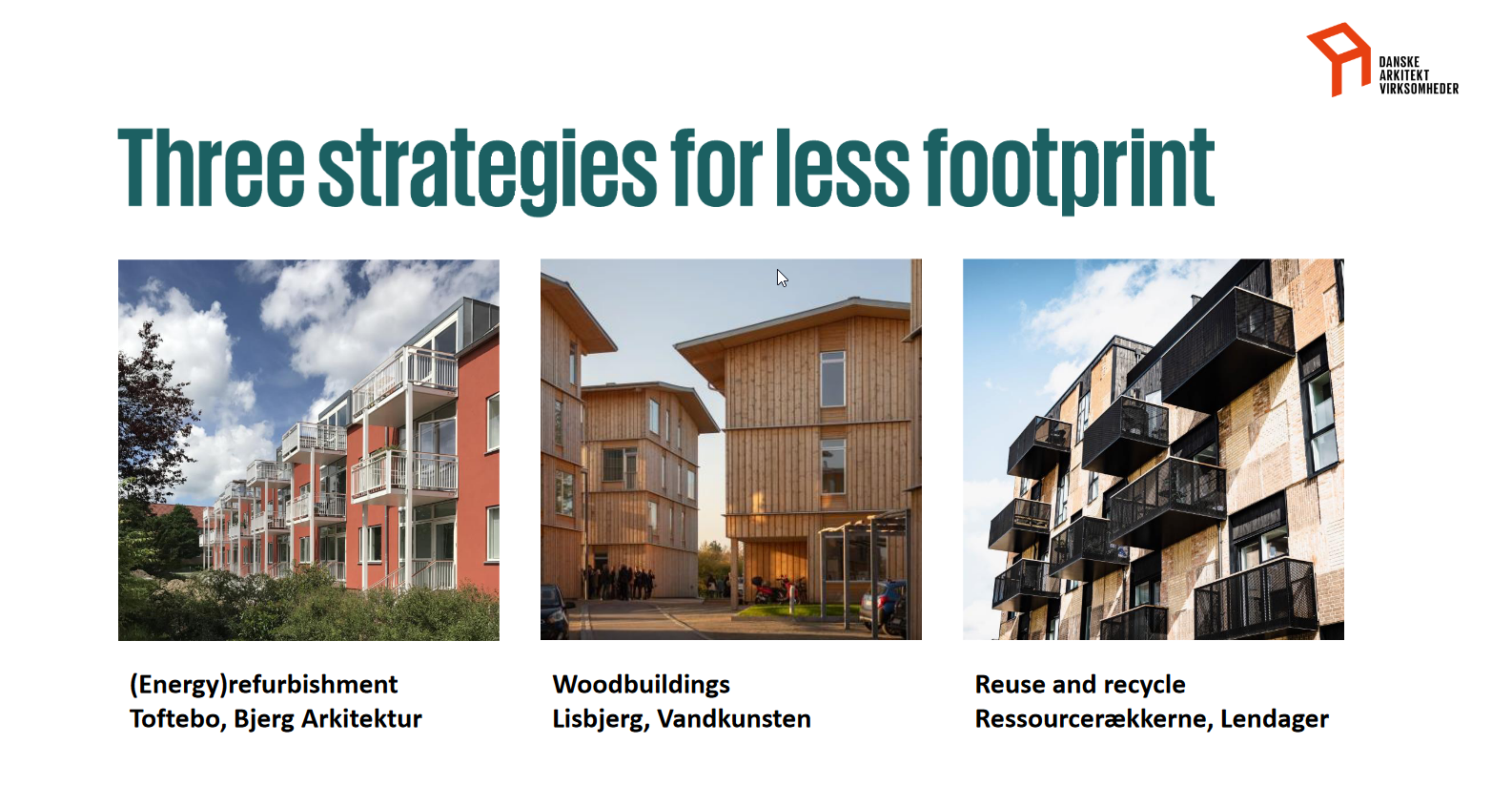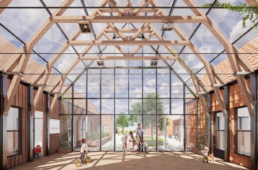How are climate change, the construction industry and BIM connected?
It is common knowledge now that the construction industry is one of the major culprits of the ecological footprint. The cement industry alone is in third place for the production of CO2 after the countries of China and the USA. Time is running out, and all designers in the sector need to begin to work collaboratively to the transition towards more sustainable paths.
However, designing zero energy buildings is not enough. We must also reduce the use of materials that pollute excessively and the overly exploitation of natural resources. We need to put in place plans for reusing and recycling, and the materials to recycle should come also from waste, and not only from the demolition of buildings.

In Copenhagen, during the conference organized on December 7th by KEA (Copenhagen School of Design & Technology), it was underlined the importance of architects and engineers considering the use of appropriate materials already in the preliminary design phase. Also important is limiting the use of reinforced concrete to those buildings and structures that really need it and, wherever possible, considering alternative solutions that can be even more performing. It is also necessary to reuse the material resulting from demolitions in a smart way.
In France and Denmark, in application of the European recommendations for the reduction of the ecological footprint, the law requires the declaration of the total of CO2 produced. Not only as LCA, i.e. a simple certification of how much CO2 that particular building produces, but it is also required to justify the choice on the materials, which must produce less CO2 than alternative solutions.
During the debate following the conference it was rightly pointed out that "virgin" materials often have a lower cost than the recycled ones because the production process from raw materials is simpler than the recycling of existing materials, especially if their composition is unknown. Soon however, to encourage recycling, in Denmark it will be introduced a tax on the production of CO2, which will make the price of the two choices comparable and will possibly make recycled materials more advantageous.
In Denmark, they initiated pilot cases in which, for example, it was approved the project of a nursery school in place of an old abandoned school, provided that the materials derive from the demolition of the old structure. In place of the old school there are now two soccer fields and a nursery school built sustainably and on a zero impact criteria. This thanks to the saving of "virgin" material which normally requires a large energy contribution, both in production and for transportation. Furthermore, wood has once again become the first choice, both for new houses and for renovations.
The role and contribution of BIM in all of this was also discussed. A software was shown that BIM allows to evaluate the CO2 footprint, just as there are already 4D and 5D software that allow to evaluate times and costs. Each product is connected with its ecological footprint, i.e. with the carbon dioxide produced for its production. In this way, it is possible for the designer to attribute a real value to the ecological footprint of the entire building.
It is clear that the role of material producers is becoming more and more Impactful. They must transition from providing the values that certify the "ecological footprint" in simple pdfs, to the transmission of data that can be directly read by design software. To allow this, the bSDD is already available, i.e. a service that buildingSMART International makes available to "translate" any property and geometry into data that can be read by modeling software.
Essentially, it is enough to connect these properties and values to each element. As an example, the "wall" properties can be linked to reinforced concrete, solid bricks, hollow bricks, laminated wood, recycled panels and so on to which the manufacturer will have to associate the corresponding "CO2/metre" properties. The software, at that point, can directly calculate the final footprint.

By changing the material, in a few clicks, the final value can automatically be updated. This will facilitate the final selection.
However, there is still a long way to go. For example, we need to work on new legislative instruments that support this approach. In public tenders, it will be necessary that the ecological footprint has a weight in the selection, so that designers are encouraged to make more ecological choices. It will also be important to help small producers of recycled materials to certify their products with the CE mark in order to be able to place them in the market. It will also be necessary to properly train manufacturers and the workforce to use these new products correctly. Finally, it will be necessary to support research in this sector.

These topics will also be addressed during the next buildingSMART International Summit, which will be held in Rome from 27 to 30 March 2023.
All the European chapters of buildingSMART will also meet, on this occasion, with the European Commission (DG Growth) to look for agreements to ensure that part of the substantial funding foreseen for the construction sector will be directed to these activities. We invite you to participate numerous at the Summit, that is open to all interested parties in the sector, members and non-members of buildingSMART.
Presentation and images by Lene Espersen
Article by Anna Moreno and Caterina Nissim
BIM and sustainability in the construction industry
The use of BIM and the holistic approach to sustainability in the construction industry
Energy savings, consciousness about natural resources, reduction of pollution and respect for the environment. The theme of green development of cities is a challenge in which the construction sector has a central role to play.
Fortunately, design and technologies are moving on an increasingly “green” track: architects are always more motivated by the desire to create buildings that create dialogues between man and nature. The cities of the future are (very) slowly and gradually developing obligations to comply with environment-friendly practices and standards which, for the sake of simplicity, we will call "sustainability".
Construction is an energy-intensive sector with a high share of global pollution: it is in fact responsible for 36% of energy consumption and 39% of carbon dioxide emissions into the atmosphere. This is the reason the sector has a huge responsibility and the duty to initiate better practices and virtuous processes to reduce its impact on the planet as quickly as possible.
Augmenting the sustainability in construction is not an easy problem to tackle and there are not fast lanes bringing there. There is a large number of different tracks to consider and we can only speak about sustainability in construction following an holistic and exhaustive approach.
Too often, in construction, the scale to measure sustainability is confused and reduced to specific energy requirements. In fact, also due to a regulatory framework that has not yet been defined in Europe and sustainability assessment procedures and methods that have not yet been established, building projects are defined as sustainable only if it somehow leads to energy savings in a phase of the project's life same.
Sustainability must instead lie in the achievement of an optimal balance between the fulfillment, at different moments in time, of economic, environmental and social requirements, often in conflict with each other. All these different factors must be evaluated in a holistic and integrated way by the designer, as by all the different actors during the lifespan of the project.
Managing this large amount of information is not simple, but the BIM approach can constitute the right solution to optimize processes and achieve all the objectives on the environmental and energy front.
BIM is still often confused with a simple 3D model of the project or even with an architectural software. It consists instead in a real integrated design methodology involving all the professional figures engaged in the design, construction and maintenance of the project, contributing to the different aspects of the work.
BIM appears as a digital representation of the physical and functional characteristics of a building. It allows to share knowledge and the complete information about the property, supplying therefore a reliable basis for any decision necessary throughout the life cycle of the structure. BIM can deliver different views and aspects of the same information, such as 2D drawings, lists, texts, 3D images, animations, as well as elements of time (4D) and cost (5D).
This information is available during the entire project life cycle: mechanical and electrical layouts, design details, materials and so on in a 3D virtual space. In particular, by also including the concept of Life Cycle Assessment (LCA) analysis, the project team is able to fully assess the environmental impact.
Using the LCA analysis, all actors involved in the construction can evaluate the trend of the environmental impact from the first steps of the work such as the production of materials passing through the installation and implementation up to their disposal. The BIM also in relation to the LCA makes it possible to optimize the performance of the building as every aspect (plant engineering, lighting, energy, etc.) is evaluated in a more conscious way, allowing the work team to turn towards sustainable and lower-impact choices on the environment.
The potential of the BIM methodology in information management can therefore provide valid support for implementing LCA directly in the BIM environment with the aim of simplifying the evaluation procedures and the understanding and use of the results. Furthermore, BIM represents for many construction companies and design companies a valid decision making tool in terms of costs, times and design solutions and by extending this opportunity also to LCA assessments, it can be used profitably as a tool for assessing environmental sustainability of civil works.
To conclude, the use of BIM in the construction industry will not save the planet. However, the impact of the construction industry is a particularly heavy one on the environment, with much room for improvement and a variety of solutions to consider, from new technologies to collaborative approaches. It is the moral duty of each of us to take the necessary steps to move forward a more sustainable future.

